1963 Studebaker Antique: A Blast From the Past, this article dives into the captivating world of Studebaker automobiles from a bygone era. The 1963 Studebaker lineup, though often overshadowed by its contemporaries, boasts a unique blend of design, performance, and history.
From the iconic Avanti to the reliable Lark, these vehicles offer a glimpse into a time when American car culture was in its prime.
The 1963 Studebaker models were more than just cars; they represented a moment in automotive history, a testament to innovation and style. This era saw Studebaker embrace a bold design philosophy, pushing boundaries and challenging conventional thinking. The result was a range of automobiles that stood out from the crowd, with distinctive features that continue to fascinate enthusiasts today.
Historical Context
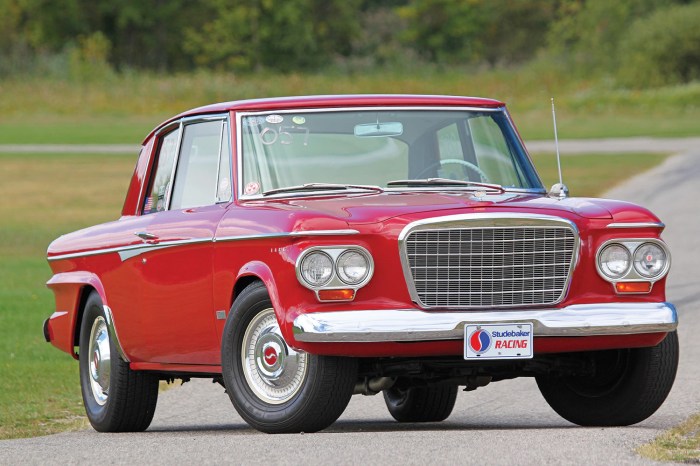
The year 1963 marked a pivotal moment for Studebaker, a once-proud American automaker facing mounting challenges in the face of intense competition from Detroit’s Big Three. Despite their valiant efforts, Studebaker struggled to maintain market share, leading to a series of strategic decisions that ultimately shaped the company’s future.
The 1963 model year witnessed the introduction of several significant changes, including a new design philosophy, a shift in focus towards smaller and more affordable models, and a desperate attempt to capture the hearts and wallets of American consumers.
Design Philosophy
The design philosophy behind the 1963 Studebaker models was a deliberate attempt to modernize the brand’s image and appeal to a wider audience. Studebaker designers aimed to create vehicles that were both stylish and practical, with an emphasis on affordability and fuel efficiency.
The company’s decision to move away from its traditional, somewhat conservative styling was driven by the need to compete with the increasingly popular compact and mid-size cars offered by Ford, Chevrolet, and Chrysler. The 1963 Studebaker lineup featured a new, more streamlined design language, characterized by flowing lines, rounded corners, and a distinctive “Coke bottle” profile.
This design approach, while visually appealing, was also intended to improve aerodynamics and fuel economy, a crucial consideration in the face of rising gasoline prices.
Comparison to Contemporary Automobiles
The 1963 Studebaker models were positioned against a diverse range of competitors in the American automotive market. The compact Lark, for example, faced off against popular models like the Chevrolet Corvair, the Ford Falcon, and the Plymouth Valiant. In the mid-size segment, the Studebaker Avanti, with its sleek and sporty design, competed with the Ford Thunderbird and the Chevrolet Corvette.
The 1963 Studebaker lineup also included a range of trucks and commercial vehicles, which competed with the likes of Chevrolet, Ford, and Dodge.
Key Events and Trends
The design and production of the 1963 Studebaker models were influenced by a number of key events and trends in the American automotive industry and society at large. The rise of the compact car segment, driven by the growing popularity of smaller, more fuel-efficient vehicles, was a major factor in Studebaker’s decision to shift its focus towards smaller models.
The increasing demand for style and performance also played a role in the design of the 1963 Studebaker models, particularly the Avanti. The growing popularity of European sports cars, such as the MG and the Triumph, inspired the Avanti’s sleek and sporty design, which aimed to capture the hearts of American performance car enthusiasts.
Models and Features: 1963 Studebaker Antique

The 1963 Studebaker lineup offered a diverse range of models catering to various tastes and needs. From the compact Lark to the sporty Avanti, Studebaker aimed to capture a wide segment of the automotive market. Each model boasted unique features and specifications, making them distinct and appealing to specific buyers.
Model Overview
The following table provides a concise overview of the 1963 Studebaker models, their key features, and specifications:| Model | Engine Options | Transmission | Seating Capacity | Notable Features ||—|—|—|—|—|| Lark | 170 cu in (2.8 L) 6-cylinder, 259 cu in (4.2 L) V8 | 3-speed manual, 3-speed automatic | 4-5 | Compact size, economical, available in sedan, wagon, and convertible body styles || Cruiser | 259 cu in (4.2 L) V8, 289 cu in (4.7 L) V8 | 3-speed manual, 3-speed automatic | 4-5 | Larger and more luxurious than the Lark, available in sedan and wagon body styles || Avanti | 289 cu in (4.7 L) V8 | 3-speed manual, 3-speed automatic | 2+2 | Distinctive aerodynamic design, powerful performance, sporty handling |
Performance and Fuel Economy
The performance and fuel economy of 1963 Studebaker models varied significantly depending on the engine and transmission combination. | Model | Engine | Transmission | Horsepower | Torque | Fuel Economy (city/highway) ||—|—|—|—|—|—|| Lark 6-cylinder | 170 cu in (2.8 L) | 3-speed manual | 101 hp | 140 lb-ft | 20/25 mpg || Lark V8 | 259 cu in (4.2 L) | 3-speed automatic | 167 hp | 255 lb-ft | 17/22 mpg || Cruiser V8 | 259 cu in (4.2 L) | 3-speed automatic | 167 hp | 255 lb-ft | 16/21 mpg || Avanti | 289 cu in (4.7 L) | 3-speed manual | 210 hp | 280 lb-ft | 15/20 mpg |
Avanti: A Design Icon
The 1963 Studebaker Avanti stands out as a true design icon, showcasing Studebaker’s innovative spirit and commitment to style. The Avanti’s sleek, aerodynamic body, designed by Raymond Loewy, was a departure from the conservative styling of the era.
“The Avanti was the first car to use a fiberglass body, which made it lighter and more aerodynamic than its competitors.”
The Avanti’s performance capabilities were equally impressive. Its powerful 289 cu in (4.7 L) V8 engine, coupled with its lightweight construction, allowed it to achieve speeds exceeding 120 mph.
Legacy and Impact
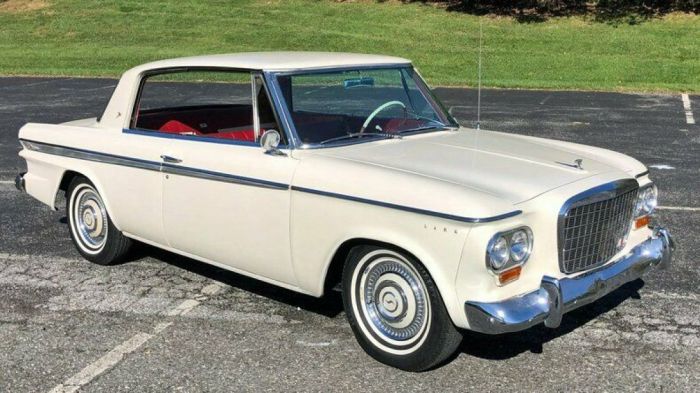
The 1963 Studebaker models, despite their short-lived production, left a lasting impression on the automotive world. They represented a bold departure from the traditional design language of the time, and their unique features and styling continue to be admired by enthusiasts today.
The 1963 Studebaker Antique is a classic car that’s known for its sleek design and powerful engine. If you’re looking for a car that’s a bit more vintage, you might want to check out the 1953 Studebaker Champion. This model has a more classic look, but it’s still a great car for cruising around town.
Both the 1963 Studebaker Antique and the 1953 Studebaker Champion are great examples of classic American automobiles.
Stories and Anecdotes
The 1963 Studebakers were known for their distinctive design and innovative features. One of the most popular models was the Avanti, a sporty coupe that was ahead of its time in terms of aerodynamics and performance. Many enthusiasts remember the Avanti for its sleek lines, powerful engine, and luxurious interior.
The Lark, a compact car, was also a popular choice among consumers. It offered a combination of practicality and affordability, making it a popular choice for families.
“My grandfather had a 1963 Lark, and it was the family car for years. It was a reliable and comfortable car, and it was always a conversation starter.”
An enthusiast
The 1963 Studebaker Antique, with its sleek lines and powerful engine, was a head-turner in its day. While the 1963 model boasted a modern design, the earlier Studebakers like the 1949 Studebaker 2R5 had a distinct charm of their own, with their iconic rounded bodywork and chrome accents.
Both models represented a time when American car manufacturers were pushing the boundaries of style and engineering, and the Studebaker brand, though eventually overshadowed by larger competitors, left a lasting mark on automotive history.
Impact on Popular Culture
The 1963 Studebaker models have appeared in numerous movies and television shows. The Avanti, in particular, has been featured in several films, including “The Thomas Crown Affair” (1968) and “The French Connection” (1971). The Lark was also featured in several popular television shows of the 1960s, such as “The Andy Griffith Show” and “The Beverly Hillbillies.”
Lasting Impact on the Automotive Industry
The 1963 Studebaker models had a significant impact on the automotive industry, particularly in terms of design and engineering. The Avanti’s aerodynamic design, for example, was a major influence on the development of future sports cars. The Lark’s compact size and fuel efficiency also helped to pave the way for the development of smaller, more fuel-efficient cars.
Influential Automotive Designers and Engineers
The 1963 Studebaker models were the product of the work of several talented automotive designers and engineers.
- Raymond Loewy: An American industrial designer who is credited with designing the Avanti. Loewy was a pioneer in the field of aerodynamic design, and his work on the Avanti helped to shape the future of automotive design.
- Brooks Stevens: An American industrial designer who is known for his work on the Lark. Stevens was a proponent of functional design, and his work on the Lark helped to make it one of the most popular compact cars of the 1960s.
- Robert Bourke: An American engineer who was responsible for the development of the Avanti’s engine. Bourke was a pioneer in the field of high-performance engine design, and his work on the Avanti helped to make it one of the most powerful cars of its time.
Collecting and Restoring
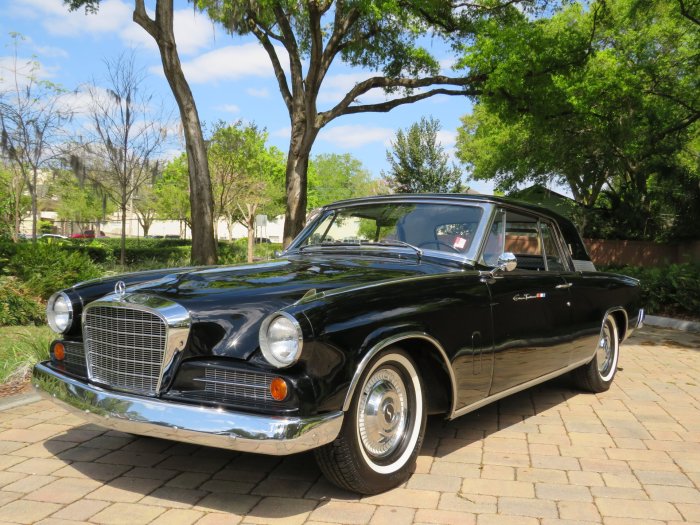
Owning a 1963 Studebaker is a dream for many classic car enthusiasts. These vehicles are not only stylish but also represent a significant piece of American automotive history. However, restoring a Studebaker to its former glory requires a deep understanding of the model’s nuances, common restoration challenges, and the availability of parts.
This section provides a guide for identifying authentic models, addressing restoration hurdles, understanding the value and rarity of different models, and navigating the world of parts and resources for restoring your 1963 Studebaker.
Identifying Authentic Models
Authenticating a 1963 Studebaker requires a keen eye for detail and familiarity with the model’s unique features. Here’s a guide to help you identify genuine Studebaker models:
- VIN Number:The Vehicle Identification Number (VIN) is the most reliable way to verify the authenticity of a Studebaker. It’s a 17-character alphanumeric code that’s typically located on the driver’s side dashboard, under the hood, or on the frame. The VIN should match the information on the title and other documentation.
You can use online VIN decoders to verify the authenticity of the VIN and retrieve information about the vehicle’s original specifications.
- Body Style and Trim:Studebaker offered various body styles and trim levels in 1963, each with distinct features. Pay attention to the details of the bodywork, such as the grille, taillights, and wheel covers, to ensure they match the specific model and year.
For example, the Lark model featured a unique grille and taillights, while the Avanti had a distinctive aerodynamic design.
- Engine and Transmission:1963 Studebakers were equipped with a variety of engines and transmissions. Verify that the engine and transmission are original to the vehicle or have been replaced with correct, period-correct components. Refer to the Studebaker parts catalog or online resources to confirm the appropriate engine and transmission combinations for your model.
- Interior and Accessories:The interior and accessories of a 1963 Studebaker can provide clues about its authenticity. Examine the upholstery, dashboard, and instrument panel for original materials and markings. Look for any period-correct accessories, such as radios, seat belts, and steering wheels.
Common Restoration Challenges, 1963 Studebaker Antique
Restoring a 1963 Studebaker can be a rewarding experience, but it also comes with its fair share of challenges. Here are some common issues you might encounter:
- Rust:Studebaker models from this era are susceptible to rust, especially in areas prone to harsh weather conditions. Rust can affect the body panels, chassis, and other components. Removing rust and restoring the affected areas is a crucial step in any restoration project.
- Engine and Transmission:Finding original or period-correct engine and transmission components can be challenging, especially if the original parts are worn out or damaged. You may need to source replacement parts from specialist suppliers or rebuild existing components.
- Interior Components:Original interior components, such as upholstery, dashboard parts, and door panels, can be difficult to find in good condition. You may need to source replacements from salvage yards, specialized suppliers, or consider having them reupholstered or restored.
- Electrical System:The electrical system in a 1963 Studebaker can be complex and prone to issues. Troubleshooting electrical problems and finding replacement components may require the expertise of a qualified mechanic or electrician.
Solutions for Restoration Challenges
- Rust Repair:Rust repair can be a time-consuming and labor-intensive process. You may need to replace rusted panels, repair damaged areas with metal patches, and apply rust-preventative coatings. Professional body shops can provide expertise and resources for tackling complex rust repairs.
- Engine and Transmission:Finding replacement engine and transmission parts can be challenging, but specialist suppliers and online marketplaces can offer a variety of options. Consider rebuilding existing components if they are still in reasonable condition.
- Interior Restoration:Interior restoration can be achieved through a combination of sourcing replacement parts, reupholstering, and restoring existing components. Specialized upholstery shops can provide professional services for reupholstering seats, door panels, and other interior elements.
- Electrical System:Troubleshooting electrical problems requires patience and a methodical approach. Consult electrical wiring diagrams and use a multimeter to diagnose issues. Specialized electrical shops can provide expertise and replacement parts for restoring the electrical system.
Value and Rarity of 1963 Studebaker Models
The value and rarity of 1963 Studebaker models vary depending on several factors, including the model, condition, and originality. Here are some insights:
- Lark:The Lark was the most common Studebaker model in 1963. While not as rare as other models, well-preserved examples can still be valuable, especially those with unique options or features.
- Avanti:The Avanti is a highly sought-after model due to its distinctive design and limited production. Well-restored Avantis can command high prices, especially those with original components and a documented history.
- Cruiser:The Cruiser was a luxury model that offered a more upscale experience. Well-preserved Cruisers with original features can be valuable, especially those with rare options or modifications.
- Rare Models and Options:Certain models and options are more rare than others. For example, the Hawk GT, a high-performance version of the Hawk, is a rare and desirable model. Studebakers with unique options, such as factory air conditioning or power steering, can also be more valuable.
Parts and Resources
Finding parts for restoring a 1963 Studebaker can be a challenge, but several resources are available:
- Studebaker International:Studebaker International is a dedicated organization that provides support and resources for Studebaker enthusiasts. They offer a parts catalog, online forums, and a network of members who can provide assistance with sourcing parts.
- Specialist Suppliers:Several specialist suppliers specialize in Studebaker parts. These suppliers offer a wide range of original and reproduction parts, from engine components to interior trim.
- Online Marketplaces:Online marketplaces, such as eBay and Craigslist, can be good sources for finding used Studebaker parts. Be sure to carefully inspect any parts you purchase to ensure they are in good condition.
- Salvage Yards:Salvage yards can be a good source for finding original Studebaker parts, but availability can be limited. You may need to contact multiple salvage yards to find the specific parts you need.
Visual Representations
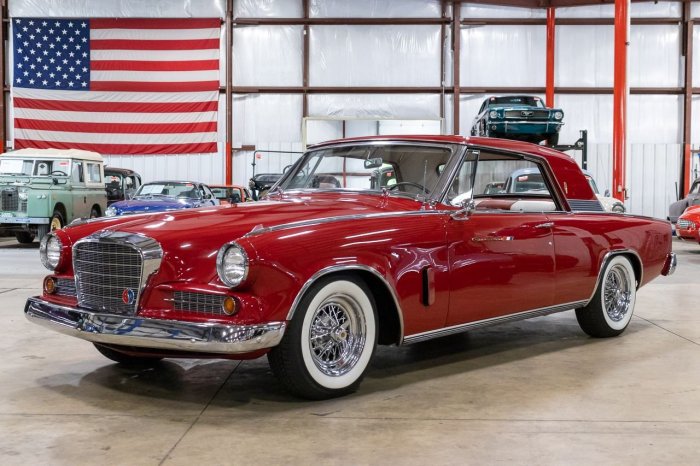
The 1963 Studebaker models were known for their unique and distinctive styling, reflecting the era’s evolving automotive design trends. The exterior and interior design elements played a crucial role in shaping the brand’s visual identity.
Exterior Design
The 1963 Studebaker models featured a range of exterior design elements that set them apart from their competitors. The most notable aspect was the adoption of a more streamlined and aerodynamic design, with rounded edges and flowing lines. The front grille was characterized by a prominent horizontal chrome bar that extended across the width of the vehicle, while the headlights were integrated into the bodywork for a more cohesive look.
The rear end featured a distinctive taillight design, often with a wraparound style.
- Paint Schemes:Studebaker offered a wide array of paint schemes for its 1963 models, catering to diverse tastes. Popular choices included solid colors like red, blue, and green, as well as two-tone combinations. The availability of optional chrome trim further enhanced the visual appeal of the vehicles.
- Trim:The trim on the 1963 Studebaker models varied depending on the specific model and trim level. The base models featured simple chrome trim, while the higher-end models boasted more elaborate chrome accents, including side moldings, wheel covers, and window surrounds.
The chrome trim added a touch of elegance and sophistication to the vehicles.
Interior Design
The interiors of the 1963 Studebaker models were designed with comfort and functionality in mind. The dashboard was typically styled with a clean and modern look, often featuring a combination of chrome accents and woodgrain trim. The seats were upholstered in a variety of materials, including cloth, vinyl, and leather, depending on the trim level.
- Upholstery:The upholstery options for the 1963 Studebaker models ranged from basic cloth to luxurious leather. The use of color and patterns varied depending on the model and trim level, with some models offering two-tone interiors for a more personalized look.
The upholstery choices played a significant role in defining the overall ambiance and character of the interior.
- Features:The 1963 Studebaker models offered a range of interior features, including optional power steering, power brakes, and air conditioning. The availability of these features varied depending on the specific model and trim level. The inclusion of these features aimed to provide a more comfortable and convenient driving experience.
1963 Studebaker Avanti
The 1963 Studebaker Avanti was a standout model that exemplified the brand’s commitment to innovative design. The Avanti was a sporty two-door coupe with a distinctive fastback design that was ahead of its time. Its sleek and aerodynamic bodywork, coupled with its powerful engine, made it a true performance car.
The Avanti’s distinctive styling was characterized by its low-slung profile, wraparound windshield, and integrated rear window.
The Avanti’s design was so revolutionary that it even earned a spot in the prestigious “Top 100 Cars of All Time” list compiled by the Automobile Magazine.
Studebaker Logo Evolution
The Studebaker logo has undergone several transformations throughout the company’s history. The 1963 models featured a simplified version of the Studebaker logo, which was introduced in 1956. This logo consisted of a stylized “S” within a circle, representing the company’s initials.
The logo was typically displayed on the front grille, steering wheel, and other exterior and interior elements. The 1963 logo retained the simple and elegant design, symbolizing the brand’s commitment to quality and craftsmanship.
Conclusion
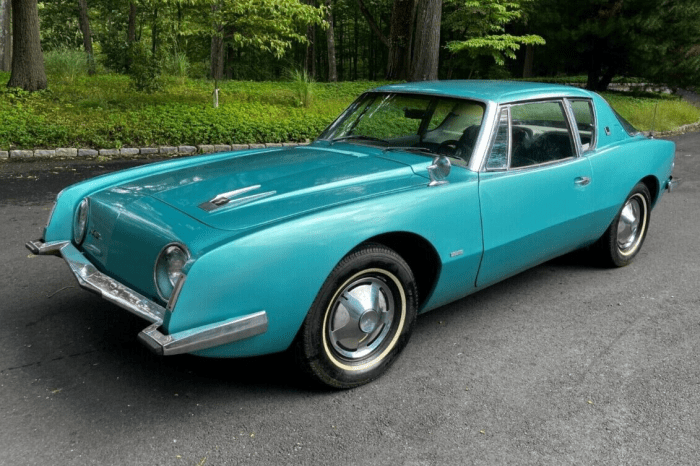
The 1963 Studebaker Antique models remain a captivating testament to a bygone era of American automotive ingenuity. These cars, with their distinctive styling and intriguing history, continue to hold a special place in the hearts of collectors and enthusiasts. Whether you’re a seasoned car aficionado or simply curious about the past, the world of 1963 Studebaker Antique offers a captivating journey through time.